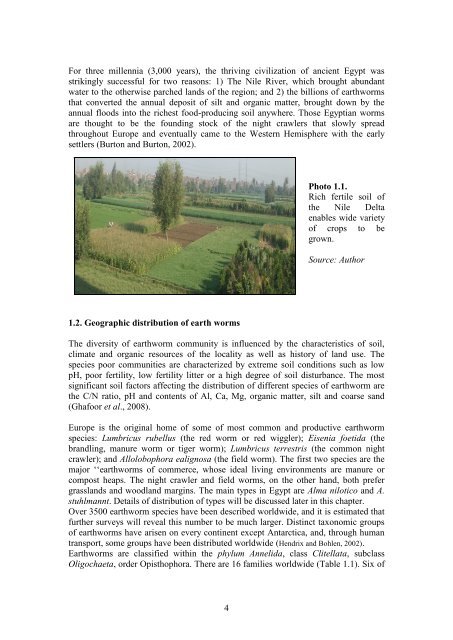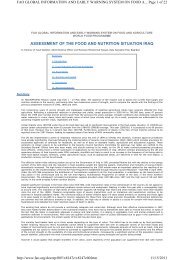Vermiculture in Egypt: - FAO - Regional Office for the Near East and
Vermiculture in Egypt: - FAO - Regional Office for the Near East and
Vermiculture in Egypt: - FAO - Regional Office for the Near East and
You also want an ePaper? Increase the reach of your titles
YUMPU automatically turns print PDFs into web optimized ePapers that Google loves.
For three millennia (3,000 years), <strong>the</strong> thriv<strong>in</strong>g civilization of ancient <strong>Egypt</strong> was<br />
strik<strong>in</strong>gly successful <strong>for</strong> two reasons: 1) The Nile River, which brought abundant<br />
water to <strong>the</strong> o<strong>the</strong>rwise parched l<strong>and</strong>s of <strong>the</strong> region; <strong>and</strong> 2) <strong>the</strong> billions of earthworms<br />
that converted <strong>the</strong> annual deposit of silt <strong>and</strong> organic matter, brought down by <strong>the</strong><br />
annual floods <strong>in</strong>to <strong>the</strong> richest food-produc<strong>in</strong>g soil anywhere. Those <strong>Egypt</strong>ian worms<br />
are thought to be <strong>the</strong> found<strong>in</strong>g stock of <strong>the</strong> night crawlers that slowly spread<br />
throughout Europe <strong>and</strong> eventually came to <strong>the</strong> Western Hemisphere with <strong>the</strong> early<br />
settlers (Burton <strong>and</strong> Burton, 2002).<br />
1.2. Geographic distribution of earth worms<br />
4<br />
Photo 1.1.<br />
Rich fertile soil of<br />
<strong>the</strong> Nile Delta<br />
enables wide variety<br />
of crops to be<br />
grown.<br />
Source: Author<br />
The diversity of earthworm community is <strong>in</strong>fluenced by <strong>the</strong> characteristics of soil,<br />
climate <strong>and</strong> organic resources of <strong>the</strong> locality as well as history of l<strong>and</strong> use. The<br />
species poor communities are characterized by extreme soil conditions such as low<br />
pH, poor fertility, low fertility litter or a high degree of soil disturbance. The most<br />
significant soil factors affect<strong>in</strong>g <strong>the</strong> distribution of different species of earthworm are<br />
<strong>the</strong> C/N ratio, pH <strong>and</strong> contents of Al, Ca, Mg, organic matter, silt <strong>and</strong> coarse s<strong>and</strong><br />
(Ghafoor et al., 2008).<br />
Europe is <strong>the</strong> orig<strong>in</strong>al home of some of most common <strong>and</strong> productive earthworm<br />
species: Lumbricus rubellus (<strong>the</strong> red worm or red wiggler); Eisenia foetida (<strong>the</strong><br />
br<strong>and</strong>l<strong>in</strong>g, manure worm or tiger worm); Lumbricus terrestris (<strong>the</strong> common night<br />
crawler); <strong>and</strong> Allolobophora ealignosa (<strong>the</strong> field worm). The first two species are <strong>the</strong><br />
major „„earthworms of commerce, whose ideal liv<strong>in</strong>g environments are manure or<br />
compost heaps. The night crawler <strong>and</strong> field worms, on <strong>the</strong> o<strong>the</strong>r h<strong>and</strong>, both prefer<br />
grassl<strong>and</strong>s <strong>and</strong> woodl<strong>and</strong> marg<strong>in</strong>s. The ma<strong>in</strong> types <strong>in</strong> <strong>Egypt</strong> are Alma nilotico <strong>and</strong> A.<br />
stuhlmannt. Details of distribution of types will be discussed later <strong>in</strong> this chapter.<br />
Over 3500 earthworm species have been described worldwide, <strong>and</strong> it is estimated that<br />
fur<strong>the</strong>r surveys will reveal this number to be much larger. Dist<strong>in</strong>ct taxonomic groups<br />
of earthworms have arisen on every cont<strong>in</strong>ent except Antarctica, <strong>and</strong>, through human<br />
transport, some groups have been distributed worldwide (Hendrix <strong>and</strong> Bohlen, 2002).<br />
Earthworms are classified with<strong>in</strong> <strong>the</strong> phylum Annelida, class Clitellata, subclass<br />
Oligochaeta, order Opisthophora. There are 16 families worldwide (Table 1.1). Six of





